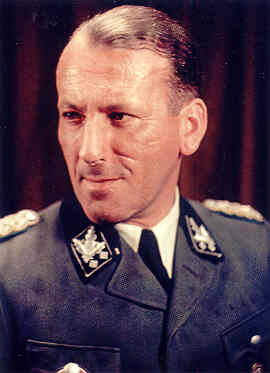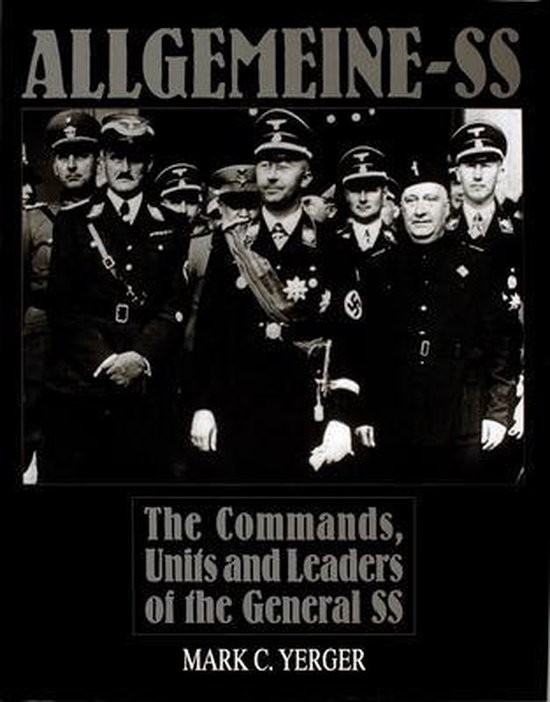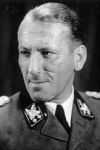The Devil's Advocate
Ernst Kaltenbrunner’s life began on October 4th, 1903 in Reid im Immkreis (Austria), close to Hitler’s birthplace Braunau. He was the son of lawyer Hugo Kaltenbrunner and his wife Therese Kaltenbrunner-Udwardy. Father and mother Kaltenbrunner were anti-religious and champions of the unification of Austria and Germany. In 1918, Ernst Kaltenbrunner moved to a boardinghouse in Linz. In this town he attended the Realgymnasium (grammarschool) and met Adolf Eichmann, one of his future coworkers. After graduating from the Realgymnasium he took a course in chemistry for a short time at the Technische Hochschule (Technical Academy) in Graz. He did not complete this course but switched to the study of law, completing it succesfully in 1926. During his study his sustained himself carrying coal.
After receiving his degree in law, he gained experience as apprentice-lawyer in Linz and Salzburg. Subsequently he became an associate in a lawfirm in Linz in 1928. In the same year he became a member of the rightist radical Turnverein and a year later he joined the Heimwehr (Home defence), a paramilitary organisation orientated towards Germany. His politicl preferences and his desire to merge Austria with Germany ultimately drove him to the Austrian NSDAP, becoming a member on October 18th, 1930.
In order to be able to strenghten the expansion of National socialism in Austria, Kaltenbrunner became a member of the Austrian branch of the Schutzstaffel (SS) on August 8th, 1931. In 1932, he continued his work as a lawyer in the office of his father. He provided free legal assistance to other nationalsocialists when they had to appear in court. Within the SS, he was active as a staffmember of SS-Abschnitt (section) VIII, the branch of the Allgemeine-SS which encompassed all of Austria at the time. The first promotion he received within the SS was his appointment on June 15th, 1934, as Führer (leader) of 37.SS Standarte (regiment) in Linz. He held this post exactly one year. Subsequently he was Führer of SS-Abschnitt VIII between June 15th, 1935 up to March 12th, 1938.
In the meantime he had married Elisabeth Eder.
SS leader of Austria
In the course of his career as (future) leader of the Austrian branch of the German SS, Kaltenbrunner was arrested by the Austrian government for his political activities and the SS was banned. The Austrian SS continued underground however but in 1935 and 1936, Kaltenbrunner was imprisoned twice; in January 1935, along with a number of other Austrian Nazis, in a camp near Kaisersteinbruch. During his imprisonment, he seemed to have been the initiator and leader of a hungerstrike among the prisoners. Anyway, his release and that of 490 other Nazis was accelerated by the Austrian government. The following year he was arrested and imprisoned again. He was charged with high treason but after an investigation lasting a few months, this charge was dropped. Susequently he was convicted for conspirarcy and sentenced to six months imprisonment. Moreover, his license to practice law was revoked.
On March 12th, 1938, German troops invaded Kaltenbrunner’s fatherland and the country was annexed by Germany. Kaltenbrunner let it be known that the SS was available to the new government and he waited for Hitler’s orders. On March 15th, 1938, Hitler named the Austrian Nazi leader Arthur Seyss-Inquart Reichsstatthalter (stadtholder) of Austria. Kaltenbrunner was appointed Secretary of Public Security within the Austrian administration. Meanwhile, Austria was divided into two Oberabschnitte (main regions); Alpenland and Donau (Danube). Kaltenbrunner was in charge of Oberabschnitt Donau (until May 1938, it was named Österreich - Austria) until January 31st, 1943. He also was Höhere SS und Polizeiführer (HSSPF, supreme chief of SS and police) in this region from September 11th, 1938 until January 31st, 1943. Apart from his role within the SS, he was a member of the German Reichstag from January 1939 until the capitulation by Germany on May 8th, 1945.
In the first months after the Anschluss (annexation), Kaltenbrunner was co-responsible for the Gleichschaltung, the transformation of the government and the bureaucracy according to nationalistic ideas and values. He had the security situation in his region firmly under control. Being HSSPF and Secretary of Public Security, Kaltenbrunner supervised the Zentralstelle für Jüdische Auswanderung (Central Agency for Jewish emigration) run by Adolf Eichmann. This agency put great pressure on Jews, extorting vast amounts of money from them, to persuade them to leave the country. Kaltenbrunner was also involved in the establishemnt of concentration camp Mauthausen, visiting this camp on a number of occasions. Kaltenbrunner would soon become involved more closely in the "solution of the Jewish question".
Heydrich's replacement
On May 27th, 1942, Czech resistance fighters made an assassination attempt on Reinhard Heydrich in Prague. He died from his injuries in hospital on June 4th. Heydrich had been in charge of the Reichssicherheitshauptamt (RSHA, Head office of State Security), the major office of the SS from September 1939 onwards, were the powers of the Sicherheitspolizei, Gestapo (Geheime Staatspolizei, Secret State police), Kriminalpolizei (Criminal police) and the Sicherheitsdienst (Security Service) converged. This main office was charged with various police and security tasks and the Endlösung (final solution) was shaped here. Following Heydrich’s death, Himmler was in charge of the RSHA for more than six months but a new chief had to be found . Amazingly enough, Himmler rejected various persons who seemed to be eligible for this post, such as the chief of the Gestapo Heinrich (Gestapo) Müller and he chose Kaltenbrunner as the new chief of the RSHA, he was simultaneously appointed secretary of state in the German department of Foreign Affairs. Kaltenbrunner started in his new function with the rank of SS-Gruppenführer. As early as April 1st, 1941, he had been promoted to Generalleutnant der Polizei (Leutenant-general of police). On June 21st, 1943, he was promoted to SS-Obergruppenführer and General der Polizei. With his rank of SS-Obergruppenführer, he was equal to quite a number of other leaders in the Reichsführung-SS (Administration of the SS). Ultimately he would attain the rank of General der Waffen-SS on December 1st, 1944.
When Kaltenbrunner commenced working in his new function as chief of the RSHA, the policy and procedures of this main office had already been developed by Heydrich in such a way that he could continue Heydrich’s work in a similar fashion. Kaltenbrunner therefore did not initiate big re-organisations and changes in policy but his involvement in the various crimes committed by the Nazis was not any less. Being subordinate to Himmler and full of conviction and motivation he was responsible for the arrest and deportation of Jews, gypsies, homosexuals and other minority groups and such. His direct subordinates were, among others the chief of the Gestapo, Heinrich Müller and Adolf Eichmann. He also was responsible for the HSSPFs who themselves were responsible for various forms of suppression, violence and mass murder within their own regions. Many decrees and orders, including orders for execution and for deportation to extermination camps were issued and signed by Kaltenbrunner. The vast amount of documents signed or drafted by him, provided his prosecutors in Nurnberg with ample evidence for no less than 13 specific charges.
Most of the charges against Kaltenbrunner referred of course to his supervison of the Gestapo and the Sicherheitsdienst and his involvement in the crimes which were committed in the concentration- and extermination camps. A somewhat differrent charge referred to an order he had given to the Sicherheitspolizei and the SD. Members of these organisations were to encourage civilians to murder American and British pilots who had been shot down over German territory. At a conference with the heads of the various departments of the RSHA he said the following about it: "All offices of the Sicherheitspolizei and SD must be informed they are not to interfere in pogroms by civilians against downed English and American terror flyers. On the contrary, this hostile mood is to be encouraged." Kaltenbrunner was also charged with involvement in the murder of 50 British prisoners of war who had escaped from the prison camp Stalag Luft III but had subsequently been recaptured. Along with the chief of the Kriminalpolizei Arthur Nebe and Gestapo chief Heinrich Müller, Kaltenbrunner drafted a false declaration about their death which would be presented to the Red Cross. The cause of death given was that they had perished during bombing attacks or that they had been shot during their escape, resisting arrest.
On November 15th, 1944, Kaltenbrunner was awarded the Ritterkreuz des Kriegsverdienstes mit Schwertern (Knight’s Cross of Service in Wartime with Swords), a high decoration that was awarded 211 times during Woirld War Two, for his efforts as chief of the RSHA. By the way, this was certainly not the only decoration he received. As of May 6th, 1942, he also was for example the proud bearer of the so called Blutorden for his early involvement in the party and the struggle for power, a decoration for Alte Kämpfer (former warriors) of the NSDAP.
The final years of the war
Owing to his close involvement with the arrest and punishment of those involved in the conspiracy of July and the subsequent failed attempt on Hitler by Claus Schenk Graf von Stauffenberg, Kaltenbrunner associated well with Hitler. He spent much of his time in the Reichskanzlei and established a close friendship with Martin Bormann, Hitler’s influential private secretary. Meanwhile, Kaltenbrunner had incorporated the tasks of the German militatry intelligence sevice, the Abwehr in the RSHA and subsequently gained a monopoly on the policy of intelligence and security within the Third Reich. The end of his imperium loomed however as the Third Reich was on the brink of collapse. April 20th, 1945, Kaltenbrunner as well as other high ranking Nazis paid a birthday visit to Hitler in Berlin. It was the last time he saw the Führer for ten days later, Hitler committed suicide in his bunker beneath the Reichskanzlei.
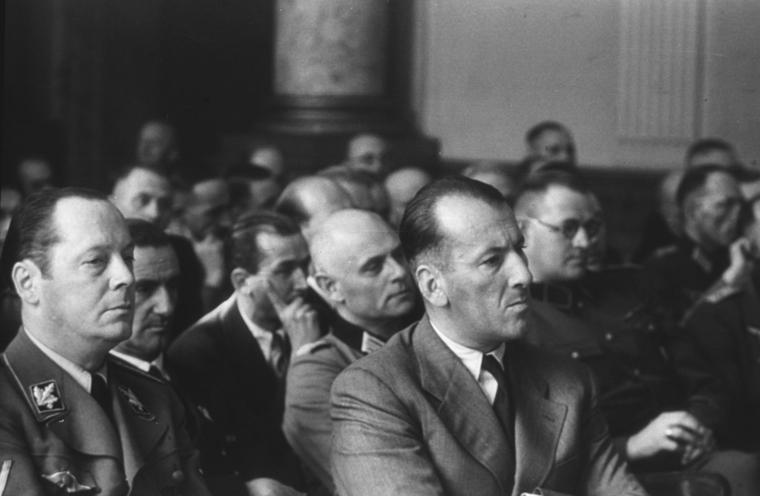
Kaltenbrunner at the Volksgerichtshof during a case against the conspirators of July 20. Source: Bundesarchv, Bild 151-17-03/CC-BY-SA 3.0.
Prior to Hitler’s suicide and Germany’s capitulation on May 8th, 1945, Kaltenbrunner relocated the RSHA to Bad Aussee in Austria. He wanted to continue resisting the Allies from this so called Alpenfestung (Bulwark in the Alps) but nothing came of guerilla warfare in the region of the Alps. On the contrary, he undertook failed attempts at negotiations with the western Allies through Allen Welsh Dulles, an associate of the American Office of Strategic Services (OSS) in Switzerland.
According to data of the SS, Kaltenbrunner took a ‘treasure’ to the Austrian Alps. This treasure would consist of five cases of precious stones and jewelry, 110 lbs in gold bars from the Deutsche Bank, 50 cases of various golden objects and coins, two million dollars, the same amount in Swiss francs and a collection of postage stamps valued at five million marks. Very likely, the majority of these valuables had been confiscated from victims of the exterminationcamps. For the time being, there is no trace whatsoever of this fabulous treasure.
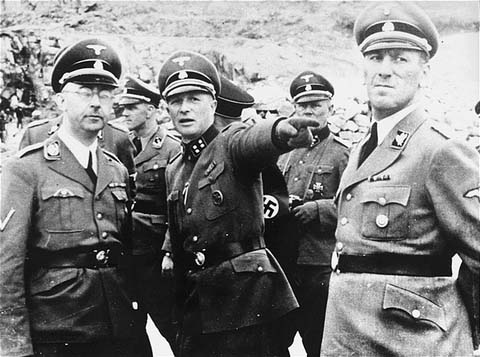
Ernst Kaltenbrunner (right) and Heinrich Himmler in Mauthausen. The man pointing is camp commander Franz Ziereis. Source: Archiv KZ-Gedenkstätte Mauthausen
Nuremberg
Kaltenbrunner was arrested by American troops right after the war. As Himmler had committed suicide on May 23rd, 1945, Kaltenbrunner was, in the opinion of the Allies, the most important SS leader still alive who could be held accountable for numerous severe war crimes. He, as well as other important war criminals, stood trial before the International Military Tribunal in Nuremberg. For this trial, four major indictments were drafted, Kaltenbrunner being charged with three. Owing to his bad health, caused by brain hemorraghes, he attended the trial only intermittently. He defended himself by flatly denying many facts that were presented and he even claimed he was not aware of the plan of the Nazis to exterminate all Jews in Europe, even though evidence was presented to the effect he had witnessed a gassing in an extermination camp at least once. During the trial he refused to serve as Himmler’s deputy and stated he had only done his duty. In his own words, he hardly knew Adolf Eichmann, his subordinate except for the fact they had been childhood friends in Linz.
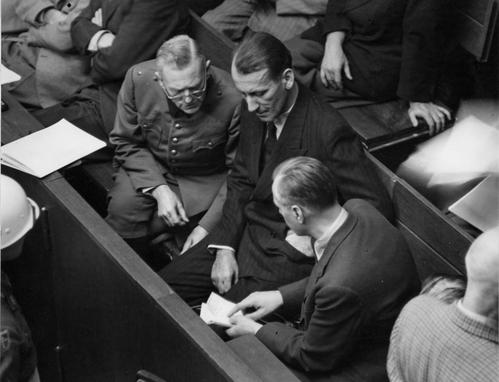
A private affair between Wilhelm Keitel (left), Ernst Kaltenbrunner (center) and Alfred Rosenberg during their trial. Source: USHMM
The judges saw through Kaltenbrunne’s denials and pronounced him guilty on two of the three counts: violation of the regulations of war and crimes against humanity. He could not be found guilty on the first charge: conspiracy to seize power in order to establish a totalitarian regime to wage aggressive war. Obviously his involvement in the early years of the Nazi party was not considered serious enough. On October 1st, 1946, Kaltenbrunner was sentenced to death and on October 16th, his sentence was executed. Prior to being hanged at 01:39, he made the following short statement: "I would like to say something. I have loved my German people with a warm heart. And my fatherland. I have done my duty in accordance with the law of my people and I regret that crimes have been committed of which I was not aware" The hood was placed over his head and with his last words, he wished Germany luck.
See also: Final statement Kaltenbrunner Verdict Kaltenbrunner
Definitielijst
- Abschnitt
- Description for a district of the Sturmabteilung (SA) or the Schutzstaffel (SS).
- Abwehr
- Term used for the German military intelligence unit during the WW1 and WW2. From 1935 onwards under command of Admiral Wilhelm Canaris. The organisation often came into conflict with other secret services such as the SD and the Gestapo. During World War 2 under Canaris frequently a source for conspiracies against the Nazi regime until in 1943 a major conspiracy by a number of prominent members of the Abwehr was discovered and the Abwehr was placed under command of Himmler. After the assassination attempt on Hitler in 1944, Canaris was discharged and the Abwehr was dissolved. The conspirators and Canaris were prosecuted and in 1945 they were executed atc oncentration camp Flossenburg.
- Alpenfestung
- Fortification in the Alps. The first development spotted by the Americans in 1944. The Americans feared a stronghold in the Alps as a last resort of the Nazis. The plan was covered in mystery. On the one hand the Alpenfestung might be the last SS stronghold which could lead to defeat of the Allied forces. Enormous arms depots were built and Nazi elite troops would be able to hide everywhere in the Alps and cause death and despair behind enemy lines, sometimes even in allied uniforms. This terrifying development was fed by German propaganda trying to lure the American forces towards the Alps and away from the Rhine. Although the British warned against this, the Americans decided to divide their forces and had them advance towards Berlin as well as the south. The Alpenfestung turned out, however, to be nothing but a spectre.
- Alte Kämpfer
- “Old fighters”. German soldiers with experience on the war front. Sometimes used within the NSDAP for those who had been fighting for the same cause before. Soldiers with battle experience were considered heroes by recruits and the home front, especially towards the end of the war.
- Anschluss
- The joining of Austria to Germany. The annexation of Austria by Nazi Germany on 12 March 1938. Austria became part of Greater Germany.
- Blutorden
- “Blood Order”. German decoration awarded in 1934 to those members of the NSDAP who had participated in the Bierhalleputsch of 1923.
- capitulation
- Agreement between fighting parties concerning the surrender of a country or an army.
- concentration camp
- Closed camp where people are being held captive that are considered to be anti- social, enemies of the state, criminal or unwanted individuals. These groups mostly do not get a fair trial or are condemned to doing time in a camp.
- crimes against humanity
- Term that was introduced during the Nuremburg Trials. Crimes against humanity are inhuman treatment against civilian population and persecution on the basis of race or political or religious beliefs.
- Endlösung
- Euphemistic term for the final solution the Nazis had in store for the “Jewish problem”. Eventually the Endlösung would get the form of annihilating the entire Jewish people in extermination camps.
- Führer
- German word for leader. During his reign of power Adolf Hitler was Führer of Nazi Germany.
- Gestapo
- “Geheime Staatspolizei”. Secret state police, the secret police in the Third Reich.
- Gleichschaltung
- “Standardisation”, “equalisation”. Aim of the NSDAP to model all social and cultural organisations to the national socialist ideal. Nobility and other traditional structures were targeted, as were other pluralist phenomena.
- Jews
- Middle Eastern people with own religion that lived in Palestine. They distinguished themselves by their strong monotheism and the strict observance of the Law and tradition. During World War 2 the Jewish people were ruthlessly persecuted and annihilated by the German Nazis. . An estimated 6,000,000 Jews were exterminated.
- Mauthausen
- Place in Austria where the Nazi’s established a concentration camp from 1938 to 1945.
- National socialism
- A political ideology drawn up by Hitler based on the superiority of the German race, the leader principle and fierce nationalism that was fed by the hard Peace of Versailles. National socialism was anti-democratic and racist. The doctrine was elaborated in Mein Kampf and organised in the NSDAP. From 1933 to 1945 National socialism was the basis of totalitarian Germany.
- Nazi
- Abbreviation of a national socialist.
- Oberabschnitt
- Main district of the protection squadron (Schutzstaffel), the SS, from November 1933.
- regiment
- Part of a division. A division divided into a number of regiments. In the army traditionally the name of the major organised unit of one type of weapon.
- resistance
- Resistance against the enemy. Often also with armed resources.
- RSHA
- Reichssicherheitshauptamt. The central information and security service of the Third Reich.
- Schutzstaffel (SS)
- The Schutzstaffel commanded by Heinrich Himmler was a very powerful organisation within the Third Reich. The original goal of the SS was to protect Adolf Hitler and other Nazi’s but soon the SS was deployed for several military, security and police tasks. The SS guarded inter alia the concentration camps and manned the Einzatzgruppen. The armed branch of the SS was the Waffen-SS.
- socialism
- Political ideology aiming at slight or no class differences. Means of production are owned by the state. Evolved as a response to capitalism. Karl Marx tried to substantiate socialism scientific.
- Standarte
- Paramilitary unit, about the size of a regiment, within the Sturmabteilung (SA) and Schutzstaffel (SS).
- Waffen-SS
- Name of Military section of the SS.
- war crimes
- Crimes committed in wartime. Often concerning crimes committed by soldiers against civilians.
Information
- Article by:
- Kevin Prenger
- Translated by:
- Arnold Palthe
- Published on:
- 19-01-2025
- Feedback?
- Send it!
Related books
Sources
- GELLATELY, R., Neurenberg-gesprekken, J.M Meulenhoff, Amsterdam, 2004.
- KERSHAW, I., Hitler - Vergelding 1936-1945, Het Spectrum, Utrecht, 2003.
- KNOPP, G., Hitlers moordenaars, Het Spectrum, Utrecht, 2004.
- TISSIER, T. LE, The Third Reich, After the Battle, 2005.
- YERGER, M., Allgemeine-SS, Schiffer, Atglen, 1997.
- Nazi Conspiracy and Aggresion. Vol. II. USGPO, Washington, 1946,pp.575-584 (link)
- Axis Biographical Research
- Deutsches Historisches Museum Berlin
- Wikipedia (Engels) - Ernst Kaltenbrunner
- www.ww2awards.com
